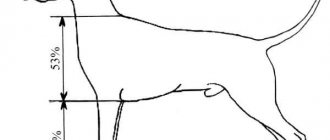pros
- The owner will not have problems with the dog’s pregnancy and subsequent births; he will not have to think about what to do with the unwanted offspring - destroy them or distribute them “in good hands.”
- The financial aspect is also important: having spent once on the operation, the owner will be spared the costs of caring for a pregnant bitch and her puppies, which costs a pretty penny.
- The operation has social significance - the number of stray dogs on city streets does not increase.
- Males lose interest in a spayed female as the estrus ceases.
- The animal is less susceptible to attacks of aggression, almost does not fight with other dogs, and therefore is less likely to be injured.
- The likelihood of developing mammary tumors is reduced, especially if the operation is performed before the dog’s first heat, which corresponds to the age of 4-6 months, for some breeds - up to a year. The risk of other diseases of the genital organs - the uterus and ovaries, and malignant neoplasms is eliminated.
- The bitch will not get sick with sexually transmitted venereal sarcoma, when foul-smelling tumor growths form on the mucous membrane of the genital organs. Treatment will usually require chemotherapy.
- Life expectancy increases by 20%, the pet remains active and playful longer.
- The pet will not run away from home to find a sexual partner, so the owner will not have to waste time looking for him.
- If the pet lives indoors, then the problem of frequently cleaning after her during heat is solved, and the characteristic smell disappears.
- Behavior and character improve: the dog does not howl, does not urinate in inappropriate places, and its anxiety disappears.
Sterilization
The sterilization operation is somewhat more complicated. After it, the genitals produce a certain amount of sex hormones with all the ensuing consequences: the struggle for territory or a sexual partner, the desire to find a sexual partner, mark territory, etc.
Sterilization of a Labrador is possible, in principle, at any age, but it is advisable to do it while the puppy is still small - at the age of 5-8 months. Animals that are spayed at an early age recover from surgery faster than those that have the surgery done later.
Minuses
- The operation is performed under general anesthesia, which puts stress on the pet’s body, and especially on its heart.
- Conditioned reflexes in sterilized dogs are developed somewhat worse. For example, if you click on the nose of an unsterilized animal, it immediately remembers the prohibition. After surgery, it will take some time to acquire the reflex.
- The risk of obesity increases as metabolic patterns change.
- Complications are possible during surgery - bleeding, rupture of sutures, hernia, infection, inflammation.
- Some time after sterilization, urinary incontinence may develop, which leads to urinary tract diseases of varying severity. After the removal of organs, a cavity is formed in the peritoneum, and the bladder is displaced, with a change in hormonal levels. But this warning applies mainly to large breeds weighing more than 30 kg.
Castration of a dog: pros and cons of surgery, at what age
The behavior of animals largely depends on their temperament. And if the Labrador was active and mobile before the operation, then he will most likely remain so. Some Labradors gain weight after sterilization. Of course, this fact can be considered as a negative consequence of sterilization. But it must be remembered that with active exercise and a balanced diet with a reduced calorie content, you can control the dog’s body weight within the limits of its breed and physical norm. Another side effect to note is that large breed bitches sometimes experience urinary incontinence after spaying, but this tends to occur with a higher uterine amputation (close to the bladder neck).
So:
1.
It is necessary to sterilize animals from which it is not planned to produce offspring, in order to reduce the risk of mammary tumors and pathologies of the reproductive system. Prevention is easier than treatment and is more than 20 times cheaper!
2.
It is necessary to sterilize animals that, if pregnant, will not be able to normally bear and give birth to offspring due to any congenital or acquired pathologies (hip dysplasia, fracture of the pelvic bones, etc.).
3.
It is necessary to sterilize vicious and aggressive animals for personal safety and the safety of others.
4.
Before the operation, the animal owner should remember that in females it is advisable to remove both the ovaries and the uterus at the same time (ovariohysterectomy).
5.
When deciding whether or not to spay, a pet owner should always remember the responsibility they have to their animal. And also about a certain anesthetic risk, since the operation is performed under general anesthesia.
This article is based on data obtained from 750 dogs and 1200 cats that underwent ovariohysterectomy.
— the term sterilization used in the article is intended for animal owners, because this is more easily understood. Sterilization involves stopping the reproductive function. In fact, ovariohysterectomy (or orchitectomy) is called castration, i.e. removal of the gonads, followed by a lack of ability to reproduce. Sterilization is correctly called an artificial violation of the reproductive function, without removing the gonads (ovaries or testes), while the hormone-producing function is preserved.
- tumors of the mammary glands. Twenty years of experience of European colleagues has reliably proven that castration of cats or bitches before the first heat reduces the risk of AMF by 50 times.
— not all authors agree with the thesis that removal of the ovaries reduces the risk of recurrence of removed breast cancer. The preferred surgical method is total mastectomy, i.e. removal of breast cancer and unaffected mammary gland packages, as well as inguinal and axillary lymph nodes.
— According to statistics, urinary incontinence occurs in one out of 20 bitches over 6 years old and larger than 35 kg. Also, one of the factors of incontinence is a change in the tone of the urinary sphincter as a result of changes in hormonal levels.
Labrador retriever puppies for exhibitions, hunting, homes, stud dogs for mating, exhibitions, assistance in raising, consultations.
E-MAIL mob. 8-905-739-97-21, 8-926-552-75-54
©
1998 by Ens Lumens. All rights reserved. Please do not use any image without written permission.
Contraindications
An ovariohystrectomy is often performed, removing the ovaries and uterus.
Take the Attention Test! Find 10 differences! (click right here!)
Find the answer Are you bothered by some problem or question? Enter “Breed” or “Name of the problem” into the form, press Enter and you will find out everything about the issue that interests you.
Due to their body structure, there are breeds for which surgery can lead to complications. These include breeds with a flattened short muzzle - pugs, bulldogs.
Consider medical contraindications: cardiovascular failure, impaired renal function, etc. Animals older than 5 years are at risk. But most contraindications are relative. The operation is carried out at the discretion of the doctor, who evaluates all possible dangers. The qualifications of the doctor are also important.
It is impossible to sterilize breeding animals that were purchased for breeding, since after the operation this will become impossible.
If we take into account the possible risks to the animal’s health, then after 2 years and 6 months of life, it makes no sense to carry out surgery for prophylactic purposes (so that the animal does not get sick). Some doctors advise doing this at two months of age, believing that the puppy tolerates the procedure more easily. But then the risk of hypoplasia (underdevelopment) of the vagina and vulva increases, which is why a complication such as perivulvar dermatitis develops.
They try not to carry out sterilization in the following conditions:
- Pregnancy;
- Estrus;
- feeding puppies.
To perform an operation during these periods, you must have serious medical reasons.
Myths about dog sterilization
- Abdominal surgery has serious consequences.
- The animal gains excess weight after the procedure.
- Sterilization leaves a noticeable scar on the body.
- The dog will urinate frequently.
- Hormonal deficiency will appear.
- Behavior will become unpredictable.
- The dog will start to worry.
With timely sterilization, the risks of complications are minimal. Animals are usually operated on until they are 2 years old. Young individuals quickly recover and within a day begin their normal lifestyle; after the sutures are removed, the pet and owner forget about the operation. Modern anesthesia guarantees complete pain relief at the time of surgery, after which painkillers can be prescribed.
There are special foods for sterilized dogs. You need to change food immediately after surgery. Compliance with the regime and proportions will not lead to your pet gaining excess weight.
Prestigious veterinary clinics use high-quality suture material that does not leave hard scars; they also use absorbable threads that do not need to be removed.
Urinary incontinence after the procedure occurs rarely, mainly in large breeds or if the bitch was operated on immediately after giving birth, or in old age.
During the operation, the connection of the adrenal glands only with sex hormones is broken; the production of other hormones does not decrease. Hormonal deficiency is rare and has nothing to do with sterilization. The risks are equal for both operated and non-operated dogs.
Sterilization does not affect hunting and guard abilities. Behavior changes for the better, the pet will become less aggressive, stop marking its territory, and will not strive to escape.
The dog's worry about the absence of reproductive organs is a false conclusion. The dog will not experience any psychological trauma or stress.
Sterilization of a Labrador – benefits for your dog
Neutering your Labrador is usually the best course of action for owners, both from a health and social responsibility perspective.
Many health problems can be minimized or even completely eliminated after this procedure, not to mention the problem of unwanted puppies can be controlled.
Spaying your Labrador can also bring about positive changes in the personality of male Labradors and even improve their concentration!
A miracle can happen!
In this article, veterinary experts discuss the benefits that owners may see after spaying their Labrador.
The benefits of sterilization (castration) of males and puppies.
Besides control of offspring, there are a number of very good reasons to castrate (remove the testicles) of male dogs. They are mainly divided into two categories: behavioral and medical.
Regardless of which category you are talking about, most unwanted characteristics or conditions are caused by the male hormone testosterone, which is produced in the testicles. This is the main reason that vasectomies have never been more popular in veterinary medicine.
Vasectomy eliminates successful reproduction, but it does not eliminate any of the unwanted problems of an unspayed male, as it does not affect the production of testosterone and its distribution throughout the dog's body.
Behavioral benefits of castration
Reduced level of aggression:
One of the most important behavioral benefits of neutering is that as adults these dogs will tend to be less aggressive towards both other male dogs and people.
Androgenic (male) hormones, of which testosterone is the most important, are responsible for the development of many behavior patterns. When 7 and 8 month old puppies are sexually attracted to their same littermates, it is due to the production of androgens in their bodies.
The same goes for aggressive behavior. Some medications that have androgenic hormonal activity often lead to increased aggression (an example is contraceptives that contain androgenic chemical elements).
The extent to which castration suppresses aggression varies depending on the animal and the age at which it is performed. The best effect is achieved when carried out before the age of one year.
Reduced desire to find a female
The second behavioral benefit of neutering is that these dogs will not "walk" when they sense a female in heat. Males are able to sense the current female thanks to pheromones. These are airborne chemical attractants released by the female during her cycle.
They travel through the air over vast distances. We grew up on a farm where the nearest house was over a mile away, but when one of our bitches had a leak, the dogs would walk for miles to her, upwind and upwind. By the way, pheromones are very effective stimulants.
In the seventies, it was quite popular to perform vasectomies on dogs, in the belief that it would not deprive our canine counterparts of the “pleasure of sex.” The problem with this judgment was that many of us kept our dogs locked up in the house, in a kennel, or on a chain.
Now think about the psychological stress a vasectomized male experiences when he is locked up but can sense a current female several blocks away.
There is no pleasure in sex when he is trapped within the confines of your property, unable to mate with her.
If a dog is neutered at an early age, he will not sense or respond to pheromones, and will of course be less stressed and want to stay indoors.
Increased concentration
The third behavioral benefit occurs when you train, work with, or use the dog for field work. When neutered, it will be a much better learner with a much greater attention span when current females are nearby. This is due to the fact that he will not be constantly distracted by the stimulation of pheromones.
Medical benefits
The medical benefits are numerous and even more significant. Again, these are all caused by the effect of testosterone in the body or by physical problems occurring directly within the testicles. Again, a vasectomy would not provide any real or meaningful benefit in this case.
No testicular tumors
There are several different types of tumors, both benign and malignant, that arise within the testicles. As with most cancers, they are usually not noticeable until the animal is 5 years of age or older. Therefore, this will not be a problem in individuals neutered at the recommended age.
Improved genes
We all agree that males carrying harmful genetic traits such as dysplasia or epilepsy should be sterilized. We must do everything we can to prevent the spread and continuation of these conditions and others like them.
Fewer hernias
A hernia is a protrusion of an organ or parts of an organ or other structure through the walls of the cavity in which they are contained in their normal position.
Perianal hernias occur when the rectum, bladder, prostate or fat protrude through the muscular wall of the anus and are located just under the skin. This type of hernia is most common in adult, non-spayed male dogs.
Levels of testosterone and other hormones tend to relax or weaken the group of muscles near the anus. When an animal strains to defecate or urinate, weakened muscles break down and abdominal organs and fat bulge under the skin.
In short-haired breeds, this large bulge is noticed by the owner almost immediately, but in long-haired dogs, this problem can continue for months before someone notices this abnormality.
Left untreated, these organs can become damaged, unable to function, or even die from loss of blood supply. In addition, due to displacement of organs into this area, the animal may be unable to defecate or urinate correctly or completely, and may experience constipation or urinary incontinence.
Surgery to correct this condition is quite complex, and today can easily cost anywhere from $700 to $1,500 or more, depending on the severity.
Fewer perianal tumors
There are tumors whose growth is caused by testosterone stimulation. They arise near the anus and are called perianal adenomas or perianal adenocarcinomas. As with hernias, they do not occur until the dog is at least 7 years old. They require surgery and must be removed early in their occurrence to prevent recurrence. These tumors and the aforementioned hernia are very, very rare in individuals neutered at 7-8 months of age.
Fewer prostate problems
The most common medical problems corrected in dogs spayed at an early age are those related to the prostate. About 80% of all non-neutered male dogs have prostate disease. Prostate conditions such as soft tissue enlargement, cysts, and infections are associated with the presence of testosterone.
Early sterilization
Most dogs are neutered between 5 and 8 months of age. Many humane shelters and veterinarians begin neutering males even at a younger age, 6-14 weeks.
This early neutering does not affect growth rhythm and there are no noticeable differences in skeletal, physical or behavioral development between animals neutered early and animals neutered at a more traditional age. It should be remembered that younger animals require special anesthesia and are more prone to hypothermia (lower than normal body temperature) during surgery. While these changes will only change your score, early neutering is very safe.
In fact, animals that are neutered at an early age often recover faster than those that are neutered at an older age.
Bottom line
None of the behavioral or medical problems caused by testosterone are rare. Veterinarians deal with them almost daily. To put it in a way that won't please everyone, but it's still true, veterinarians will make a lot less money if everyone spays their male dogs before they're a year old.
What the owner needs to know
Sterilization is a surgical intervention in the reproductive system of an animal. When spaying a female dog, the ovaries and uterus are surgically removed; when castrating a male dog, the testes are removed.
Operations are performed in a veterinary clinic under general or combined anesthesia. Afterwards, the veterinarian will give recommendations on how to speed up your pet’s recovery.
Bitches can be spayed from an early age (from 6 months), without waiting for the first heat or first litter. Males can also be neutered from six months of age.
Sterilization is not carried out if:
- breeding planned;
- there are no objections to regular offspring;
- hemophilia was diagnosed;
- there are anesthetic risks.
When an individual has breed value, it is not sterilized, but its sexual instincts are corrected with the help of alternative drugs, however, at the age of 8 years, it is recommended to undergo surgery in order to avoid inflammatory processes and oncology.
If the owner does not object to regularly appearing puppies and if he is able to sell them in good hands, then there is no need to visit the surgeon.
A contraindication is hemophilia, a blood clotting disorder.
Anesthesiological risks, which include early or old age, are a prohibiting factor; the presence of acute, severe and advanced diseases.
The period of estrus is not a contraindication for surgical intervention, although it is undesirable to operate on the reproductive organs at this time, since the uterus is filled with blood, which can complicate the surgeon’s work.
Any stage of pregnancy can be terminated promptly; veterinarians do this if the bitch is clinically unable to bear offspring; deliberate termination of pregnancy is not approved by experts, since this process has negative consequences for the health of the female. If, due to the carelessness of the owner, the pet is expecting a litter, then you need to complete this matter with a natural solution, let the female feed the puppies until 2 months of age, then place the babies in good hands and henceforth prevent inattention, or sterilize the female.
A female dog can be spayed at any age after puberty, but the favorable time for the procedure is considered to be the period before the third heat, when the body is physiologically mature.
Optimal age for castration of dogs
Many dog owners often have a question: at what age can dogs be neutered? The optimal period for this operation is considered to be the beginning of puberty. At this time, the body is fully formed, but sexual desire has not yet had time to take over.
At this time, the dog has not yet begun to make marks wherever possible. Veterinarians recommend castration before the onset of this harmful habit. Otherwise, it will be difficult to get rid of it in the future.
It is not at all necessary to castrate the puppy; this procedure is also suitable for older males, and it will not cause complications for them. Sometimes the owners themselves postpone the operation, hoping that the dog’s unpleasant symptoms will go away on their own, namely, that the dog will lose its temper and everything will return to normal.
Important! Many veterinarians argue that first of all you need to pay attention not to the age of the dog, but to his well-being and condition. It is better to castrate an elderly and healthy dog than a young and sick one.
It is worth considering that castration of a male dog at a young age is a dangerous procedure. Of course, early castration has its advantages - the puppy will recover faster, the animal will quickly forget the stress it experienced.
However, there are many more disadvantages:
- the operation will definitely require anesthesia, which will be difficult to calculate;
- pathologies of the genitourinary system may appear in the future;
- possible development of urolithiasis;
- During the growth and development of a young body, various health problems may appear.
The age of castration may also depend on the breed. For small breeds it is recommended to carry it out from 6-7 months, but for giants much later - at a year and a half.
Animal behavior before and after
Unfulfilled sexual instincts lead to changes in the pet's behavior.
During some periods, dogs become restless, aggressive, do not listen to their owner, try to escape, mark their territory, spoil things in the house, and refuse to eat. Usually, physiologically, the female is ready to breed offspring 2 times a year, and the male’s need to satisfy the sexual instinct is observed regularly.
The best way to make life easier for dog owners and their charges is for the latter to undergo surgery to change the functioning of the reproductive system.
After the procedure:
- the reproductive function stops;
- negative traits of sexual behavior do not appear;
- the number of injuries and wandering of dogs is reduced;
- sterilized individuals are better oriented toward their owners, they become more efficient and become good companions;
- working qualities - security and hunting skills remain the same.
If bad behavior is caused by improper upbringing or illness, then it needs to be corrected in other ways.
Castration
Castrated animals without gonads are not subject to sexual instincts, therefore castration is more preferable for males and females. Like sterilization, castration is preferably carried out at an early age.
Spaying a dog before she goes into her first heat significantly reduces the risk of mammary cancer, a fairly common disease in female dogs. In addition, this will relieve your pet from periodically inappropriate behavior, as well as from a sudden influx of male dogs from all over the area to your home.
As for males, castration of a Labrador makes him much more balanced, and sometimes can even increase his concentration. Neutered males are less susceptible to diseases in the genitourinary area (especially the prostate gland - the most common disease). They become calmer and less aggressive - especially if during a walk there is a female in heat nearby.
As for the common myth that a neutered Labrador gains weight quickly, this is a big misconception. Indeed, after surgery, metabolism changes somewhat. He requires less food to maintain weight. But the problem of excess weight relates, rather, not to the dog, but to its owner.
Therefore, you should especially carefully observe the diet of a sterilized Labrador and give him appropriate physical activity.
How to decide to have surgery
The owner often struggles with indecision in this matter, having doubts about humanity and moral and ethical aspects.
It is difficult to observe pets during periods of unstable behavior. During the rut, dogs refuse food, lose weight, and experience anxiety. It is especially difficult for pet owners to observe the separation of mother and puppies when new owners come for the babies.
Sending your pet to the surgical table will save you from such troubles, as well as from responsibility for the existence of unwanted puppies.
Sterilization for dogs is not emotionally perceived in any way; they do not have a psychological perception of procreation.
Some purebred individuals who have a breeding marriage are excluded from breeding and are necessarily sterilized to prevent the hereditary transmission of pathology.
If the purebred representatives are healthy, but the owner does not want to breed puppies, then the operation will bring peace of mind to the owner and his ward. The animal suffers more from an unsatisfied sexual instinct, and not from the surgical procedure performed.
Sterilizing a dog is a humane way to rid an animal of cyclical emotional disorders and high-quality prevention of possible diseases of the reproductive organs.
Sterilization and castration - what's the difference?
Most people who are ignorant of these matters believe that castration is used exclusively for males, and sterilization for females.
However, this is not quite true. When sterilizing females, the fallopian tubes are ligated, and males - the seminal ducts. The medical name for the operation is vasectomy. In this case, the animal retains all its genital organs and continues its activity of producing hormones. Pets retain their sexual desire and can mate, but they will not have offspring.
Castration is a more radical procedure during which the animal is deprived of its reproductive organs. In female dogs, the uterus and ovaries, or only the ovaries, are removed. Both testicles are amputated in male dogs.
That is, in the first case there is a violation of sexual functions, in the second - their complete deprivation.
Alternatives to Sterilization
Some dog lovers, as an alternative, prefer special means that regulate the sexual heat of their pets.
Alternative drugs are:
- vegetable;
- hormonal.
Herbal preparations affect behavior during estrus. The harm from taking them has not been established, they are able to slightly calm the nervous system, and it is impossible to prevent an unwanted pregnancy for a pet with them. Among the herbal preparations, there are “Fitex” drops, “VetSpokoin” suspension, “Cat Bayun” infusion - despite the name, it is also used for dogs, as well as other products.
Hormonal drugs can suppress sexual instincts. These substances are available in the form of drops, tablets, suspensions, and injections. Among them are “Ovostop” (drops on the withers), “EX-5T” and “4 with a tail” (tablets), “EX-5” and “EX-7.5” (suspensions), and “Pillkan 5” sugar cubes. and others.
Before using such an alternative, you need to conduct a veterinary examination of the dog's health to identify contraindications, otherwise serious harm to health may occur. The dosage, frequency of administration, and gender compliance are important.
Before use, read the instructions.
There are a lot of side effects, frivolous and incorrect use, which can cause disruption of hormones, pathology in the ovaries and uterus, endometritis, oncology, disruption of the endocrine system and concomitant diseases.
If an individual does not have breed value, and there are no plans for dog breeding activities, then sterilization is the most effective solution to the problem of cyclical behavior and unwanted reproduction.
When using hormonal substances, be sure to conduct a veterinary examination at least once a year.
Cavitary
Abdominal surgery is practiced more often. The doctor makes an incision in the abdomen, in the navel area, through which the ovaries and uterus are removed. The postoperative suture can be in the form of adjacent nodules or continuous (cosmetic). The length of the suture depends on the volume of the organ being removed and the size of the animal.
Laparoscopic
Laparoscopic surgery is performed through a puncture using endoscopic equipment, without suturing, and without the subsequent use of antibiotics.
The implementation of this method is possible only with a full medical team - a surgeon, an assistant and an anesthesiologist, also with the appropriate surgical equipment. The laparoscopic method reduces the recovery time of the body, eliminates the need for regular suture treatment and the inconvenience of wearing a medical blanket. This method is not carried out in all veterinary clinics.
A veterinarian will help you choose a surgical method based on clinical indications.
About anesthesia for sterilizing a dog
Anesthesia used in veterinary clinics is divided into:
- intravenous;
- combined.
General anesthesia is carried out by injecting into a vein a substance that can cause some complications during and after the operation. It is impossible to take complete control over the systemic functioning of the body; the reaction is difficult to predict.
Proper preoperative preparation reduces the risk of irregular breathing or heartbeat, as well as side effects on the functioning of internal organs and the brain. Some individuals spend a long time in the rehabilitation period after general anesthesia.
Combined anesthesia is achieved using the inhalation method together with epidural anesthesia. The general condition is observed using special monitors that show any physiological changes, which makes it possible to provide timely assistance, and then there is no need to remove a dangerous substance from the blood. When the anesthesiologist stops supplying gas, the animal immediately wakes up, orientation in space is not disturbed.
In the evening, due to natural needs, the pet will ask to eat and go for a walk.
Both types of anesthesia are used in veterinary medicine, but to implement the second, appropriate equipment is required, which most clinics cannot afford.
Positive aspects of castration
Among the advantages of castration of dogs are the following:
- a dog of any gender becomes more suitable for keeping in an apartment;
- males calm down, stop showing aggression towards others and in 50% of cases mark everything around them;
- the male not only refuses to start fights, but also becomes uninteresting to other belligerent males;
- sexual desire decreases over time, and interest in the opposite sex disappears;
- dogs lose their tendency to run away and wander;
- castration prevents cancer of the genital organs in old age;
- In females, uterine pyometra most often occurs, therefore it is recommended to castrate the ovaries along with the uterus;
- the operation will protect the animal from sexually transmitted infections.
We suggest you familiarize yourself with: Features of castration of an adult cat
The animal stops worrying, its appetite increases and sleep improves, and a great desire to play and be mischievous appears. If he had attempts to gain leadership in the house, then they gradually fade away.
Of course, castration cannot completely affect the character of the pet, but only partially corrects it. For more obvious changes, training, sufficient physical activity and training are needed. In some cases, the animal becomes balanced only with age.
There is a myth that castration reduces the protective qualities of dogs, but in reality there is no connection. If the dog was an excellent watchdog, then after the operation it will remain so.
Complications after sterilization, as often happen, statistics for different types of operations
There are no 100% guarantees against postoperative complications; there is always some risk.
Possible complications include:
- internal bleeding;
- urinary incontinence;
- inflammation of the suture;
- seam divergence;
- infection;
- preservation of signs of sexual heat;
- slow metabolism.
Internal bleeding can result from poor quality work by the surgeon and poor blood clotting. The complication is manifested by paleness of the mucous membranes, low body temperature, and rapid breathing. Be sure to contact a veterinarian.
Uncontrollable urination as a complication can occur in old dogs or in bitches who have recently given birth. Inexperienced surgical intervention may also be a reason.
The junction of the tissues can become inflamed due to infrequent or improper treatment of the seam, also due to constant licking of this area. During the postoperative period, the dog must be wearing a blanket or a special collar.
Internal or external sutures may come apart due to improper application or active mobility during the rehabilitation period. At first, you need to limit your pet’s physical activity – running, jumping. If there is an external discrepancy in the incision area, a loose connection of tissues or rupture of the edges of the wound will appear, and bloody discharge is possible. When the seam diverges internally, a bulge forms at the incision site.
Operating under inappropriate conditions can lead to infection. Signs of complications include high fever, vomiting, and thirst.
The preservation of signs of sexual behavior is caused by the abandoned part of the ovary, or the preserved ovarian follicle. To determine the cause, ultrasound diagnostics are performed, then the problem is eliminated promptly or with medication.
Low production of sex hormones can slow down metabolism. The pet will begin to eat more, move less, and over time obesity and related diseases may develop. It is necessary to replace the usual diet with specialized food intended for sterilized individuals.
With the laparoscopic method, the number of negative postoperative consequences is reduced - problems with healing of the surgical wound and pain are reduced by 2 times. There is greater comfort during the recovery period and faster rehabilitation. This makes laparoscopy the preferred method.
Catering
Postoperative changes in hormonal levels do not harm the animal; the pet will remain a reliable protector and companion, but without cyclical mood swings. Catering in nursing takes first place. Since the dog will become calmer, sleep and eat more, you need to choose the right food and organize physical mobility after rehabilitation time.
You cannot feed the dog immediately after returning from the clinic, you need to wait a day, the body must recover. In the future, the diet should be changed to specialized food. If the dog is accustomed to natural food, then more raw meat and dairy products are added to the menu. For the first 14 days, feed your pet in small portions, but with increased frequency, gradually moving to the normal diet. Fatty foods can cause gastrointestinal upset, causing weight gain quickly, resulting in obesity and subsequent complications.
The best option is specialized dog food for sterilized dogs; it contains the necessary substances to maintain normal body weight.
Changes in metabolism lead to a decrease in physical activity and an increased feeling of hunger, so you need dietary food with a reduced lipid content by 13% and an increase in proteins by 10%.
The diet food includes:
- proteins;
- lipids;
- carbohydrates;
- nutritional supplements.
The special food contains easily digestible protein; it is digested faster, reducing the likelihood of obesity. Preferred food is of the highest quality, in which the protein is made from natural meat and fish, which also contains vitamins necessary for fat burning.
Lipids are fat-like substances. The diet must contain omega-3 and omega-6, so the composition includes vegetable fats and ocean fish.
Carbohydrates prevent hunger until later food consumption. Grains contain enough carbohydrates, the quality of the vitamin is important, fiber is needed instead of starch. The composition includes grains of brown rice, oats, and barley. There should not be an excess of carbohydrates; they are indicated at the end in the list of ingredients.
Some foods contain useful additives, which eliminates the need to take additional vitamins that speed up metabolism and prevent urolithiasis.
Choose food specifically for your breed using the link.
First, consult your veterinarian about choosing a brand of food.
Host reviews
Svetlana, 33 years old; breed - Labrador, 8 years 12 days
The bitch was spayed at one and a half years old. There are no side effects - urinary incontinence, obesity. I would like to note that even though the operation is considered simple, it needs to be done in good clinics. There are many cases where manipulations are carried out poorly, and then the animal is again “put under the knife.”
Anna, 27 years old; Breed: Shepherd, 5 years old
My girl has a big problem. She was spayed at the age of about 2 years and she began to quickly gain weight, although she eats little, even little. I tried to find food for her, but nothing helped.
Boris, 42 years old; breed - Dalmatian, 2 years old
Sterilization (the ovaries were removed, the uterus remained) was carried out after the first heat, at 1 year and 2 months. The girl survived the operation well. The seam healed quickly. But now, during sleep, a lot of urine leaks, which is why I have to wash the bedding frequently.
Vasily, 36 years old; breed - shepherd, 4 years, 2 years and 6 months
I spayed both females. One - before the onset of the first heat, the second - after it. The older bitch may leak urine. At first I thought it was due to sterilization. But when I started looking into it, I found out that the leakage was not caused by the operation. I am only for sterilization because my first dog died of uterine cancer. I feel guilty about this.
Angela, 25 years old; Breed: Italian Greyhound, 15 years and 6 months
Sterilization was carried out at 2 years. The girl lived to be 15 years and 6 months. Urinary incontinence began only at the age of 15. But I think it's due to old age. Overall the dog felt good.
Lika, 28 years old; breed - Rottweiler, 8 years old
The operation was performed at 4 years old. I don’t regret sterilization, because now I’m not nervous about the dirt in the house, the peace of mind of my pet and unwanted offspring. But there is one drawback: Lika “leaks” a little. There are no puddles, but a small amount of urine is released. This usually happens in winter, after hypothermia.
How much does it cost to sterilize a dog?
In Moscow, ovariohysterectomy is performed in the following clinics ( The price of the service depends on the weight of the bitch, the surgical method used and anesthesia ):
| Name of the clinic | Address | Telephone | Price (from and to) |
| Veterinary clinic Gos-Vet gos-vet.com on Bratislavskaya | District: Maryino Metro: Bratislavskaya Address: Moscow, st. Bratislavskaya, 22 Opening hours: Mon-Sun: 10-22 | +7 | from 4200 to 7000 rub. |
| Veterinary clinic Vetvrach at home 24 vetvrach-at-dom24.rf on the street. Udaltsova 75A | District: Vernadskogo Avenue Metro: Vernadskogo Avenue Address: Moscow, st. Udaltsova, 75, lit. A | +7 | from 2300 rub. |
| Veterinary clinic Unified City Veterinary Service vyzov-veterinar.msk.ru on Batyuninskaya | District: Pechatniki Metro: Maryino Address: Moscow, st. Batyuninskaya, 13 Opening hours: 24 hours a day | +7 | from 2300 rub. |
| Veterinary clinic Ya-Vet yavet.firmica.ru on the street. Pleshcheeva 15 | District: Bibirevo Metro: Bibirevo Address: Moscow, st. Pleshcheeva, 15 Opening hours: 24 hours a day | +7 | from 2300 to 2700 rub. |
| Calling a veterinarian to your home Veterinary-Doma veterinar-doma.ru on Dmitrovsky | District: Dmitrovsky district Metro: Altufyevo Address: Moscow, sh. Dmitrovskoe, 151, building 5 Opening hours: 24 hours a day | +7 | from 2500 to 4000 rub. |
| 24-hour veterinary clinic VetGlobal vetclinika.moscow on the street. Tourist | District: Northern Tushino Metro: Skhodnenskaya Address: Moscow, st. Touristskaya, 13, building 2 Opening hours: 24 hours a day | +7 | from 3000 rub. |
| mobile veterinary clinic Vet-Mobil vetmobile.firmica.ru travel to anywhere in the city | District: Yuzhnoye Tushino Metro: Skhodnenskaya Address: Moscow, st. Svobody, 39 Opening hours: 24 hours a day | +7 | from 4000 to 12000 rub. |
| veterinary clinic Alisavet butovo.alisavet.ru on Witte | District: Yuzhnoye Butovo Metro: Admiral Ushakov Boulevard Address: Moscow, al. Witte, 2 Opening hours: Mon-Sun: 9-22 | +7 +8 | from 3500 to 18000 rub. |
| veterinary clinic Bagira www.bagiravet.ru on the street. Forest | District: Tverskoy district Metro: Belorusskaya Address: Moscow, Fryazino, st. Lesnaya, 1 Opening hours: Mon-Fri: 10-20, Sat-Sun: 10-19 | +7 +7 | from 2600 rub. |
Whether or not to have an ovariohysterectomy is a personal matter for each dog owner. Many people get out of this situation by using hormonal drugs that suppress sexual desire. Veterinarians remind that long-term use of these drugs ends in health problems for the animal: at a minimum, inflammation of the uterus develops. Sterilization is an effective alternative.
Dog castration price
In any clinic, the cost of castration of dogs varies, based primarily on the size of the animal and gender. In addition, prices vary between private and public veterinary hospitals.
As a rule, in any case, castration of females will cost more. The cost of the procedure also includes the price of medications, anesthetics and materials used:
- up to 5 kg – 2000-2500 rub.
- from 5 to 15 kg – 2500-3000 rub.
- from 15 to 25 kg – 3000-3500 rub.
- from 25 to 35 kg – 3500-4000 rub.
- from 35 to 45 kg – 4000-5000 rub.
- from 46 kg and more – 5000-7000 rubles.
It is possible to call a specialist to your home, in which case the cost of the operation increases within 1000 rubles. Castration will also be more expensive at night and in the presence of associated complications.
Optimal age
An important question that responsible owners ask: “At what age should a dog be sterilized?” The surgeons have the same answer - the animal must be healthy, and how old it is, 2 or six, does not play a special role. And there are a lot of nuances in this issue.
For example, dogs older than seven years are more difficult to endure any operations, it is more difficult to recover from anesthesia, and the rehabilitation period lasts longer; the aging body recovers more slowly.
Many experienced veterinarians agree that all adult dogs over the age of eight should be sterilized, regardless of whether they have given birth frequently, once or twice in their entire lives, or have never given birth at all. In mature animals, the risk of developing cancer increases significantly, and surgery is a way to avoid terrible diseases.
If the plans are to breed the breed, then the dog’s last birth should take place at the age of six years, and then it should be sterilized without waiting for the body to age.
You can often hear different opinions about early sterilization, which is carried out before six months. This sterilization is fraught with serious consequences, which lead to significant developmental delays and the manifestation of chronic diseases. There are difficulties in calculating the appropriate dosage of anesthetic drugs and removing organs that are not fully formed. Sometimes the microscopic part of the ovary that was not removed may recover and require further surgery.
If breeding is not in the plans, then the appropriate period for sterilization is 2-3 weeks before the first heat. Carrying out surgery at this time will significantly reduce the risks of breast tumors and disruptions in the hormonal system.
It all depends on several factors:
- Breeds (small females, begin to flow earlier);
- Features of the body (if the mother dog was in heat for a year, then the daughter will have the same).
To make sure that the time has come for the operation, it is necessary to take tests to identify hormonal levels and consult with the breeder about the characteristics and hereditary predispositions of the pet.
In case of hormonal imbalance, abnormally long, heavy estrus, the bitch is subjected to sterilization, purely based on medical indicators, the facts of the presence or absence of childbirth are not taken into account.
Dog owners use sterilization to get rid of an existing pregnancy. But veterinarians warn against these operations. It is much safer for an animal to carry offspring, give birth and feed them, than to undergo surgery at this time.
During the period of bearing puppies, the bitch's uterus significantly enlarges, which leads to greater blood loss during sterilization and a longer recovery process.
If you neglected to take care of your pet, then you should let the bitch fulfill her maternal duty and 30-35 days after giving birth you can already perform the operation. At this time, there is no need to postpone the procedure, but carry it out on time.
There are options when sterilization is forced. For example, if a dog has a disease that does not allow him to bear puppies and endure the birth process, perform the operation immediately, and the sooner this is done, the better.
Disadvantages of neutering dogs
Like any other surgical intervention, castration has possible side effects and complications. Among the main disadvantages of castration of dogs is a hormonal imbalance, which cannot but affect the health of the animal.
The operation may cause the following conditions:
- The development of hypothyroidism is a disease caused by a decrease in the functionality of the thyroid gland and a decrease in the level of hormones it produces.
- Bone cancer – according to statistics, castrated males most often suffer from malignant formations in bone tissue.
- Obesity – an increase in appetite after castration often causes excess weight gain, and an obese animal is more susceptible to diseases of the cardiovascular system.
- Behavioral deviations - these can be observed in elderly castrated males.
- Changes in coat – a lack of male hormone affects the condition of the coat, it becomes softer, similar in structure to that of a puppy.
Dog owners should also be aware that animals are more susceptible to anesthesia than people. Veterinarians themselves estimate its danger to be higher than that of surgery. In this case, everything depends on proper dosage calculation. With a small dose, the dog may wake up before the procedure is completed. If the dosage exceeds the norm, there is a high risk of cardiac arrest.
Today, a number of veterinarians oppose castration, as it can still have a detrimental effect on the dog's health.
We suggest you read: Canadian Sphynx castration
Surgery and post-operative care
The operation is performed by a surgeon using general anesthesia and lasts about an hour on average. At this time, male dogs have their testes removed.
With female dogs, everything is somewhat more complicated; to remove the ovaries or ovaries with the uterus, access to the abdominal cavity is required. To do this, abdominal surgery is performed and organs are removed through an incision.
After sterilization, the dog is placed on a bedding. You need to regularly moisten your tongue and nose with water and do not give your dog plenty to drink.
You can offer your pet food only on the second day, giving preference to soft, crushed food. Pates and minced meat are suitable.
The seams will need to be treated with antiseptic agents for 10-14 days. To prevent your pet from getting wet or licking post-operative stitches, use devices - collars, blankets.
Only the owner can decide whether to sterilize a dog or not. The main thing is not to harm your beloved pet.
How does the operation take place?
General anesthesia is used to perform castration. Preparatory activities include the following:
- placing the animal on a sterile surface;
- administration of anesthesia;
- removing hair from the site of future surgery;
- disinfection of the incision area.
In male dogs, the veterinarian makes incisions in the scrotum, tightens the spermatic cord and amputates the testes.
The resulting small wounds are sprinkled with a special powder product - Tricillin, it helps to avoid complications. The procedure lasts about five minutes, and there is no need to remove sutures after surgery.
In female dogs, the operation is more complicated, since penetration occurs into the internal cavity of the body. The doctor cuts the groin area and removes the organs (the ovaries alone, or along with the uterus). The procedure lasts about half an hour. After stitches are applied, bandages are put on the animal, and sometimes a special blanket is used to prevent the dog from scratching or licking the damaged area.
Preparing for surgery
Dogs are sterilized during anestrus to prevent large-scale hemorrhage. Veterinarians advise conducting an examination to determine the method of anesthesia. It includes:
- Anamnesis. The dog owner informs the veterinary surgeon about past diseases, allergic reactions, timing of deworming, and vaccination.
- Laboratory blood tests.
- Instrumental studies - ultrasound. Attention is paid to the condition of the dog's heart.
- Expulsion of fleas.
- Starvation diet. Anesthesia causes vomiting, so to keep the dog's stomach empty, it is not fed. Some surgeons advise emptying the intestines as well. To do this, the dog is given Vaseline oil a day before surgery. It is not absorbed and does not overload the liver, unlike plant-based ones. Dogs are not given water 4 hours before sterilization.
- Before anesthesia, premedication is given - drugs are administered to support breathing and myocardial function.
- For anesthesia, intramuscular injection of Xylazine and intravenous Propofol are used. For mask or endotracheal inhalation anesthesia, mixtures of gases are used.
For all types of anesthesia, there are indications and limitations that are taken into account by the veterinary anesthesiologist.











